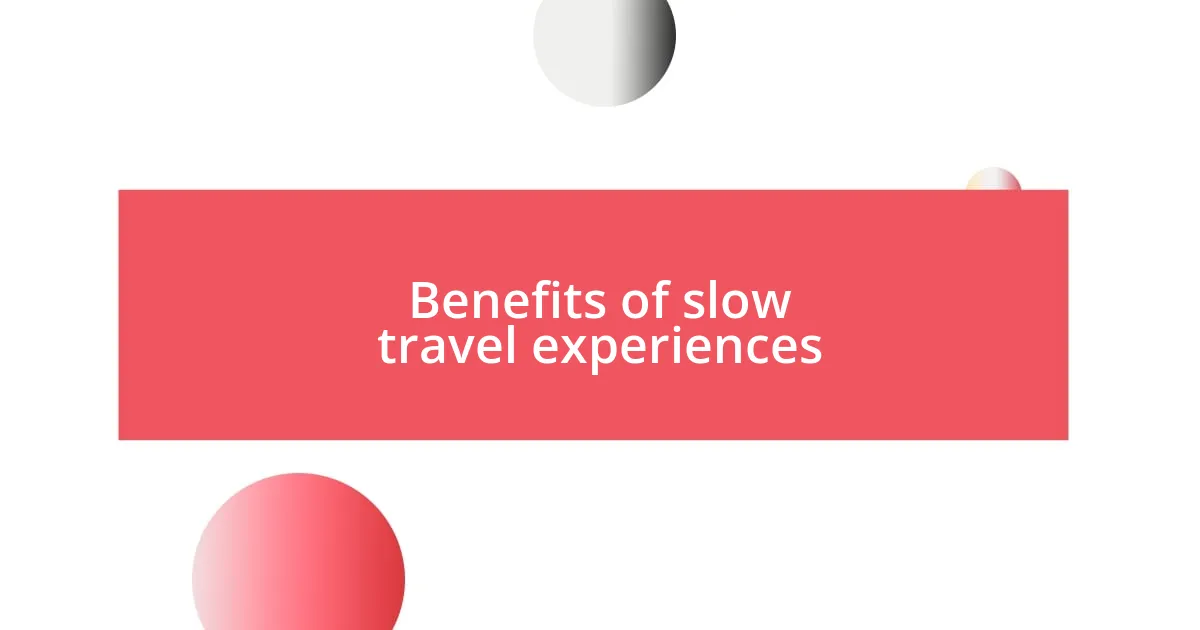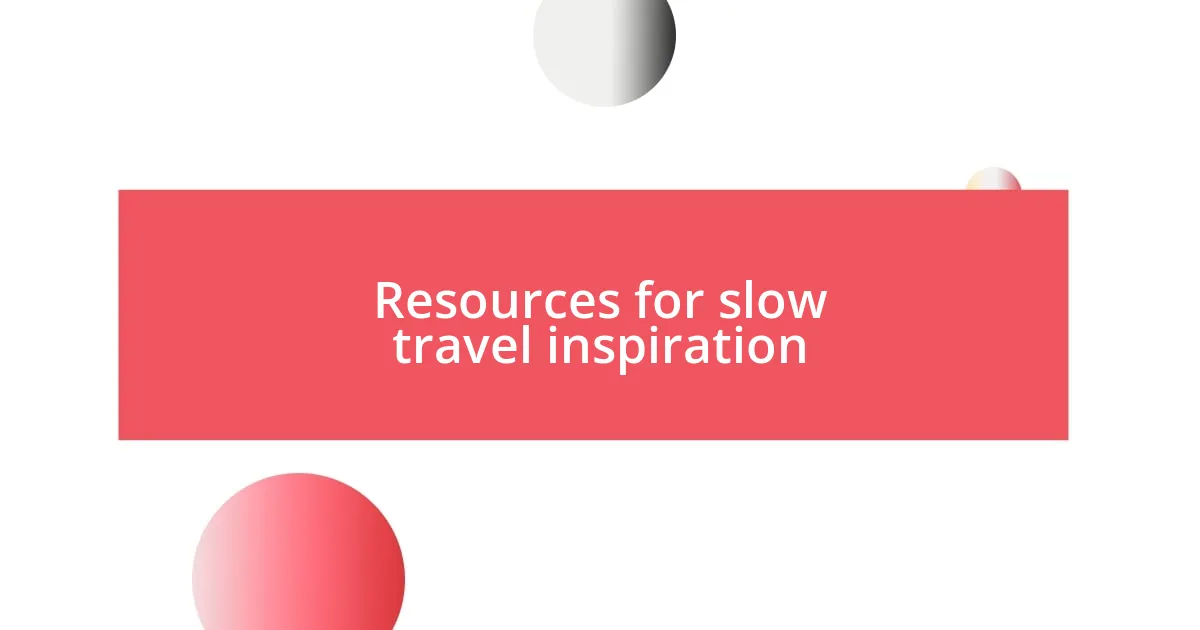Key takeaways:
- Slow travel prioritizes immersion in the cultural and local experiences over rushing through tourist attractions.
- Benefits of slow travel include deeper connections, mindfulness, enhanced learning, stress reduction, and support for sustainable tourism.
- Planning a slow travel itinerary involves flexibility, spontaneity, and focusing on meaningful interactions rather than strict schedules.
- Engagement in local cultures through shared meals, festivals, and volunteer work enriches travel experiences and fosters authentic connections.

Understanding slow travel concepts
Understanding the essence of slow travel is about embracing the journey as much as the destination. I remember a trip I took where I chose to explore a tiny village in Italy instead of rushing through major cities. This allowed me to connect with locals, savor homemade pasta, and truly appreciate the culture around me. Isn’t it intriguing how some of the most meaningful experiences come from slowing down?
Slow travel encourages a deep engagement with our surroundings. I found myself wandering cobblestone streets, stopping to chat with artisans, and even learning bits of their crafts. In those moments, I realized that each interaction became a thread in the fabric of my journey. How often do we miss these small joys when we’re glued to our itineraries?
The concept also challenges us to rethink what it means to explore. Instead of ticking off boxes on a list, I began to value quality over quantity. I recall sitting in a café, watching the world go by and feeling an incredible sense of peace. Have you ever experienced that moment of simply being, rather than doing? It’s transformative to see travel not as a checklist, but as an immersive experience that expands our worldview.

Benefits of slow travel experiences
Experiencing slow travel has profound benefits that often go unnoticed in our fast-paced world. I remember a trip to Spain where I decided to spend an entire afternoon in a vibrant market rather than racing through top attractions. The aromas of spices and freshly baked goods enveloped me, and the hustle and bustle of locals bartering created an atmosphere that felt alive and welcoming. In those moments, I understood the essence of truly experiencing a place, rather than merely visiting it.
Here are some key benefits of slow travel experiences:
- Deeper Connections: Engaging with local communities fosters genuine relationships that can last beyond the trip.
- Mindfulness: Slowing down encourages a present-moment awareness that leads to greater appreciation of the surroundings.
- Enhanced Learning: Immersion in local customs and traditions offers unique insights and a richer understanding of the culture.
- Stress Reduction: By choosing to take less crowded paths, I found my travels to be more relaxing and enjoyable.
- Sustainable Tourism: Supporting small businesses creates a positive impact on the local economy and promotes sustainability.
Each step in my journey evolved into a story that I’d cherish, reminding me that sometimes, it’s the journey that truly matters.

Planning your slow travel itinerary
When creating a slow travel itinerary, it’s essential to prioritize experiences over ticking off destinations. I recall spending a week in a small fishing village in Greece; instead of racing to Santorini, I immersed myself in local life. Each day unfolded slowly, filled with fishing expeditions and cooking classes. This kind of planning leads to connections that are hard to replicate in a rushed trip.
It’s helpful to select a few key locations where you can dive deeply into the culture. For instance, during my travels in Southeast Asia, I chose to stay in a single city for ten days instead of rushing through multiple countries. This decision allowed me to learn about the language, savor the cuisine, and even participate in local festivals. Slowing down my pace opened up a world of adventures that I never would have encountered otherwise.
Something else that’s particularly beneficial is leaving room for spontaneity in your itinerary. I remember wandering through the streets of Lisbon and stumbling upon a quaint music festival. Had I followed a rigid schedule, I would have missed the incredible local bands and the joy of dancing with locals. Incorporating flexibility not only enriches your journey but also leads to spontaneous moments that become cherished memories.
| Factor | Fast Travel | Slow Travel |
|---|---|---|
| Experience | Brief encounters, minimal immersion | Deep connections, rich experiences |
| Itinerary Flexibility | Strict schedules, little room for changes | Open-ended plans, allows spontaneity |
| Local Interaction | Sightseeing, tourist hotspots | Engagement with locals, cultural exchanges |

Techniques for embracing local cultures
During my travels, I discovered that one of the best ways to embrace local cultures is through shared meals. I vividly remember joining a family for dinner in a tiny village in Italy, where we cooked pasta from scratch. Their warmth and the stories we exchanged over the table created a bond that truly made me feel like part of the family, rather than just a visitor. Have you ever thought about how food connects people? It’s a universal language that transcends barriers and opens windows into each other’s lives.
Another technique I found tremendously enriching was participating in local festivals or events. On one of my trips to Thailand, I stumbled into a traditional water festival where the entire community came alive with joy. I joined in the festivities, soaking people with water and laughing alongside locals. This spontaneous immersion not only introduced me to local customs but also left me with lasting friendships. Isn’t it fascinating how such moments can transform our perceptions of a culture?
Lastly, I think engaging in volunteer work or community projects is a powerful method for experiencing local culture. When I volunteered at a community garden in Mexico, I learned invaluable lessons about sustainable practices straight from local residents. Their pride in their work was inspiring, and it deepened my understanding of the region’s culture. Could anything be more fulfilling than contributing to the community while soaking up its essence? These experiences have shaped my travels into meaningful journeys filled with authentic connections.

Sustainable travel practices to consider
Sustainable travel practices can significantly enhance your journey while protecting the planet. For instance, I always opt for public transportation whenever possible. On my recent trip to Sweden, I took a train from Malmö to Gothenburg, and it was a delightful way to see the countryside. Not only was it economical, but I also felt more connected to the scenery and the local way of life as I watched towns and fields whisk by outside my window.
Choosing environmentally conscious accommodations is another impactful step. I recall staying at a small eco-lodge in Costa Rica, where the staff shared their commitment to sustainability. They utilized solar energy, offered farm-to-table dining, and even created a vibrant garden to support local wildlife. It was heartwarming to see such dedication, and I left feeling inspired to adopt some of those practices back home. Isn’t it wonderful that our choices can contribute to a brighter future?
Finally, consider how you interact with the places you visit. I often participate in local conservation efforts, and one memorable instance was a beach cleanup in Hawaii. It felt rewarding to gather with locals and fellow travelers to preserve the beauty of the ocean. The camaraderie we shared while working toward a common goal made the experience not just fulfilling but also memorable. So, how can we all play a part in maintaining the beauty of our world during our travels? Each small action counts.

Tips for mindful travel journaling
Keeping a travel journal can be an immensely rewarding practice, particularly when approached with mindfulness. Personally, I find that writing in a quiet spot, perhaps overlooking a serene landscape or in a cozy café, allows me to gather my thoughts. As I jot down observations, I focus not just on what I see but also on how I feel in that moment. What if you paused to capture that fleeting sense of wonder you experience when discovering a hidden gem?
I also recommend setting aside dedicated time each day for journaling. Whether it’s in the morning with a warm cup of coffee or under the stars at night, this creates a routine that reflects your journey. I’ve had nights where the silence enveloped me, and I felt compelled to narrate my adventures, capturing the essence of every experience. Have you ever noticed how the act of writing can actually deepen your connection to your surroundings?
Lastly, let your writing flow freely without worrying about grammar or structure. I often use sketches or snippets of poetry alongside my prose, adding layers to my reflections. During my travels in Japan, I meticulously documented the delicate art of cherry blossom viewing, a moment that transcended mere beauty. Those notes have become a cherished memory, one that makes me feel the impact of that experience passionately. How might embracing creativity in your journaling enhance your travel experience?

Resources for slow travel inspiration
Exploring slow travel inspiration can come from a variety of sources, and I have discovered that travel blogs often provide fresh perspectives. I vividly remember stumbling upon a blog written by a couple traveling through Italy, sharing their experiences of leisurely exploring small towns instead of rushing through the popular tourist spots. Their stories made me rethink my own travel approach and inspired me to slow down and truly absorb the destinations I visit. Have you ever felt that a story sparked your desire to travel differently?
Books on slow travel are also rich resources. A favorite of mine is “The Art of Slow Travel” by some of those out there who truly advocate for savoring each moment on the road. The author’s musings about conscious journeys resonated so deeply with me that I even implemented their suggestions during my last road trip along the Oregon coast. Fictional narratives and memoirs can transport you to places where time feels abundant, encouraging you to savor every encounter. What stories might influence your next adventure?
Lastly, documentaries can provide profound insights and unmatched visual inspiration for slow travel. I recently watched one that showcased travelers immersing themselves in traditional cultures and sustainable practices, and it left me reflecting on how I engage with the local community. The beautiful imagery along with personal journeys shared in these films captivated me, making me realize that slow travel goes hand in hand with meaningful connections. Isn’t it fascinating how visual storytelling can alter our perceptions and aspirations when it comes to travel?













